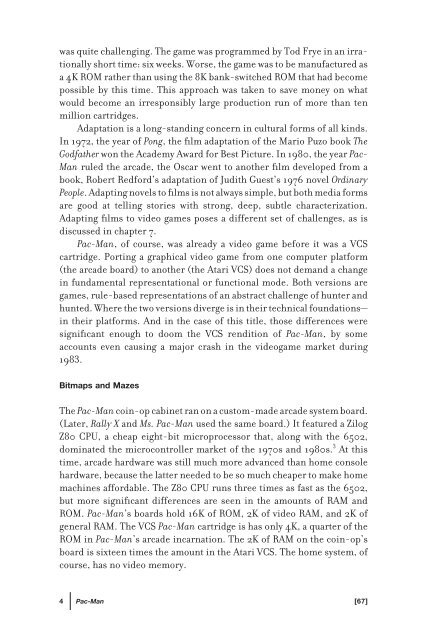Racing the Beam : the Atari Video Computer System - Index of
Racing the Beam : the Atari Video Computer System - Index of
Racing the Beam : the Atari Video Computer System - Index of
You also want an ePaper? Increase the reach of your titles
YUMPU automatically turns print PDFs into web optimized ePapers that Google loves.
was quite challenging. The game was programmed by Tod Frye in an irrationally<br />
short time: six weeks. Worse, <strong>the</strong> game was to be manufactured as<br />
a 4K ROM ra<strong>the</strong>r than using <strong>the</strong> 8K bank-switched ROM that had become<br />
possible by this time. This approach was taken to save money on what<br />
would become an irresponsibly large production run <strong>of</strong> more than ten<br />
million cartridges.<br />
Adaptation is a long-standing concern in cultural forms <strong>of</strong> all kinds.<br />
In 1972, <strong>the</strong> year <strong>of</strong> Pong, <strong>the</strong> fi lm adaptation <strong>of</strong> <strong>the</strong> Mario Puzo book The<br />
Godfa<strong>the</strong>r won <strong>the</strong> Academy Award for Best Picture. In 1980, <strong>the</strong> year Pac-<br />
Man ruled <strong>the</strong> arcade, <strong>the</strong> Oscar went to ano<strong>the</strong>r fi lm developed from a<br />
book, Robert Redford’s adaptation <strong>of</strong> Judith Guest’s 1976 novel Ordinary<br />
People. Adapting novels to fi lms is not always simple, but both media forms<br />
are good at telling stories with strong, deep, subtle characterization.<br />
Adapting fi lms to video games poses a different set <strong>of</strong> challenges, as is<br />
discussed in chapter 7.<br />
Pac-Man, <strong>of</strong> course, was already a video game before it was a VCS<br />
cartridge. Porting a graphical video game from one computer platform<br />
(<strong>the</strong> arcade board) to ano<strong>the</strong>r (<strong>the</strong> <strong>Atari</strong> VCS) does not demand a change<br />
in fundamental representational or functional mode. Both versions are<br />
games, rule-based representations <strong>of</strong> an abstract challenge <strong>of</strong> hunter and<br />
hunted. Where <strong>the</strong> two versions diverge is in <strong>the</strong>ir technical foundations—<br />
in <strong>the</strong>ir platforms. And in <strong>the</strong> case <strong>of</strong> this title, those differences were<br />
signifi cant enough to doom <strong>the</strong> VCS rendition <strong>of</strong> Pac-Man, by some<br />
accounts even causing a major crash in <strong>the</strong> videogame market during<br />
1983.<br />
Bitmaps and Mazes<br />
The Pac-Man coin-op cabinet ran on a custom-made arcade system board.<br />
(Later, Rally X and Ms. Pac-Man used <strong>the</strong> same board.) It featured a Zilog<br />
Z80 CPU, a cheap eight-bit microprocessor that, along with <strong>the</strong> 6502,<br />
dominated <strong>the</strong> microcontroller market <strong>of</strong> <strong>the</strong> 1970s and 1980s. 3 At this<br />
time, arcade hardware was still much more advanced than home console<br />
hardware, because <strong>the</strong> latter needed to be so much cheaper to make home<br />
machines affordable. The Z80 CPU runs three times as fast as <strong>the</strong> 6502,<br />
but more signifi cant differences are seen in <strong>the</strong> amounts <strong>of</strong> RAM and<br />
ROM. Pac-Man’s boards hold 16K <strong>of</strong> ROM, 2K <strong>of</strong> video RAM, and 2K <strong>of</strong><br />
general RAM. The VCS Pac-Man cartridge is has only 4K, a quarter <strong>of</strong> <strong>the</strong><br />
ROM in Pac-Man’s arcade incarnation. The 2K <strong>of</strong> RAM on <strong>the</strong> coin-op’s<br />
board is sixteen times <strong>the</strong> amount in <strong>the</strong> <strong>Atari</strong> VCS. The home system, <strong>of</strong><br />
course, has no video memory.<br />
4 Pac-Man [67]


